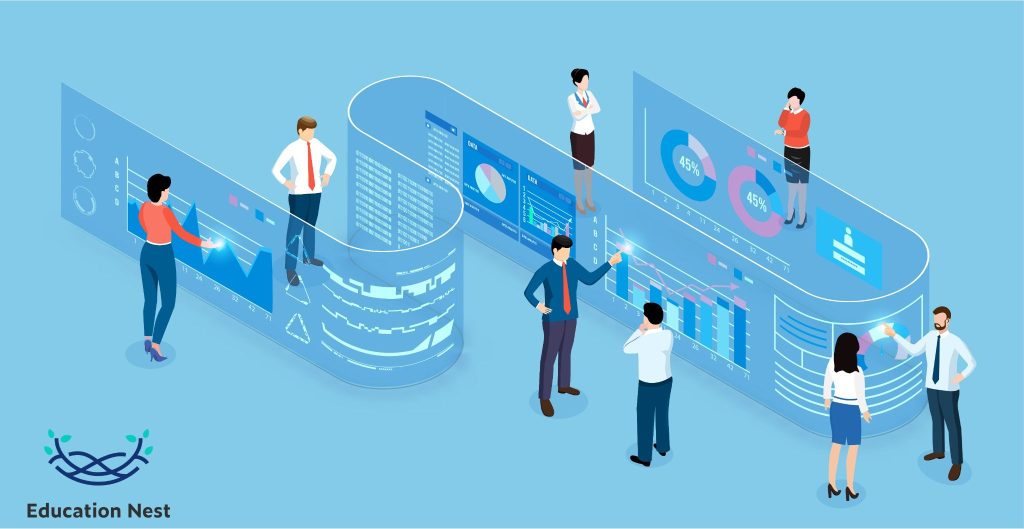
New technologies like Amazon and smartphones have added to the enormous amount of data that organizations have access to since the early 2000s, when software and hardware made it possible for businesses to handle large amounts of unstructured data. Numerous different types of databases were created to store and process the increasing amount of data. As data engineers search for methods to combine the enormous amounts of complex data that originate from sensors, networks, transactions, smart devices, the internet, and other sources, this field is constantly changing. To find and scale more complex insights, new technologies like machine learning are currently used in conjunction with big data analytics techniques.
Big Data Analytics
Big data analytics is the process of finding trends, patterns, and correlations in large amounts of raw data to help people make decisions based on the data. Statistical analysis techniques like clustering and regression are applied to larger datasets using newer tools in these processes.
Big data analysts in India usually start out with a salary of about 2.6 lakh rupees ($21,700) per year. To become a big data analyst, you need at least one year of work experience.
Big Data Analytics Jobs
The changes that big data has made in different fields have made it easier for experts in those fields to find work. Here are some big data jobs for hiring managers and people looking for work:
- Data Architect
- Database Manager
- Database Administrator
- Database Modeler
- Database Analyst

Big Data Analytics Tools
Big data analytics can be done with more than one tool or technology. Instead, you can use a combination of tools to help you collect, process, clean, and analyze large amounts of data.
The following are some tools for analyzing big data:
- Hadoop
It is a free framework for managing and analyzing massive datasets on groups of similar hardware. Making this framework a crucial component of any big data operation is a smart move because it is free and capable of handling significant amounts of both structured and unstructured data.
- NoSQL databases
These are non-relational data management systems that do not require a fixed schema. This makes them a great choice for big, raw, unstructured data. NoSQL stands for “not only SQL,” and this type of database can work with many different types of data models all at once.
- MapReduce
It is an important part of the Hadoop framework that does two things. The first is mapping, which sends data to different nodes in the cluster after filtering it. The second is reducing, which sorts and reduces the results from each node to answer a query.
- YARN
It stands for “Yet Another Resource Negotiator.” Basically, another part of Hadoop’s second-generation cluster management technology helps schedule jobs and keep track of the cluster’s resources.
- Spark
The Spark algorithm is an open-source cluster computing framework that uses implicit data parallelism and fault tolerance to provide a way to program whole clusters. Spark can use both batch processing and stream processing to do calculations quickly.
- Tableau
Also known as an all-in-one platform for data analysis, it lets you prepare, analyze, work together, and share your insights from big data. Tableau is great at self-service visual analysis because it lets people ask new questions about governed big data and share their insights easily with the rest of the organization.
Big data analytics are crucial because they enable businesses to use vast amounts of data in various formats from various sources to identify opportunities and risks. In doing so, businesses can move more quickly and boost their bottom lines.
Also Read: The Emerging Trends of a Data Scientist Salary in India
Advantages
Some of the advantages of big data analytics are:
- Cost savings
Helping businesses find better ways to run their businesses
- Product development
Getting a better idea of what customers want
- A market analysis
Keeping track of buying habits and market trends
Big data analytics is used to make different kinds of reports. Here are some examples:
- Fraud Management Report, which is usually used in banking sectors to find fraudulent transactions, hacking, unauthorized access to the account, and so on.
- Transportation companies like Meru, Ola, Uber, and Mega frequently use live tracking reports to keep track of their vehicles, customers’ requests, payments, emergency alerts, daily needs, and earnings, among other things.
- All industries primarily use the Sales Report and Analysis of Future Goals and Targets to assess their sales, revenues, and customer needs as well as to determine their future goals and targets, etc.
- There are a lot of reports based on live data that are mostly used to manage live data on entertainment sites, the stock market, and real-time Sensex data, among other things.
- Make different kinds of alarms based on different events, such as alarms made by the data center and different notifications.
Conclusion
We can conclude by saying that applying examples of big data analytics can greatly benefit many industries and businesses. We can easily find the answer to a complex question by looking at a large set of data. We can also forecast future events, which will help us make better business decisions.

